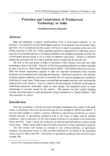Priorities and Constraints of Postharvest Technology in India
JIRCAS international symposium series
| ISSN | 13406108 |
|---|---|
| 書誌レコードID(総合目録DB) | AA1100908X |

本文フルテキスト
intlsymp-7_33-44.pdf361.64 KB
India has undergone a massive transformation from "a food grains importer" to "an exporter". It is reported to be the third largest producer of food grains in the world after China and USA. Yet it is predicted that the country will have to import food grains at the rate of 45 million tons/year by 2030 AD. India's population growth is estimated to be 1.8%/year, and to meet the increased demand due to increased population and changing food habits, growth rate of food grains should amount to 2.2 to 4.45% for different food grains. Adoption of efficient postharvest processes will be a major boosting factor in achieving this growth rate.
The bulk of the food grains in India is marketed in their primary form and very little processing is done in the fields. Majority of the food-processing industries in India is included in what is known as "Small-Scale Industrial Sector (SSIS)", with limited vision and resources. SSIS has limited organization capacity to plan for long-term investments (both towards producers and consumers) and technology development. Small-scale operations, with associated small-capacity machinery and lack of sustained effort to improve designs have resulted in inefficiency in many cases. High energy costs and high packaging costs have also restricted the rapid growth of the industry. There is a need for the development of efficient small-capacity field-drying equipment, preferably, based on solar energy, and equipment based on latest technologies is currently needed by the industry. The industry has been rapidly changing recently and shows signs of rapid development, being considered as a "Sunrise Industry", with vast potentials for export.
The bulk of the food grains in India is marketed in their primary form and very little processing is done in the fields. Majority of the food-processing industries in India is included in what is known as "Small-Scale Industrial Sector (SSIS)", with limited vision and resources. SSIS has limited organization capacity to plan for long-term investments (both towards producers and consumers) and technology development. Small-scale operations, with associated small-capacity machinery and lack of sustained effort to improve designs have resulted in inefficiency in many cases. High energy costs and high packaging costs have also restricted the rapid growth of the industry. There is a need for the development of efficient small-capacity field-drying equipment, preferably, based on solar energy, and equipment based on latest technologies is currently needed by the industry. The industry has been rapidly changing recently and shows signs of rapid development, being considered as a "Sunrise Industry", with vast potentials for export.
| 作成者 | Ananthaswamyrao Ramesh |
|---|---|
| 公開者 | Japan International Research Center for Agricultural Sciences |
| オンライン掲載日 | |
| 号 | 7 |
| 開始ページ | 33 |
| 終了ページ | 44 |
| 言語 | eng |
